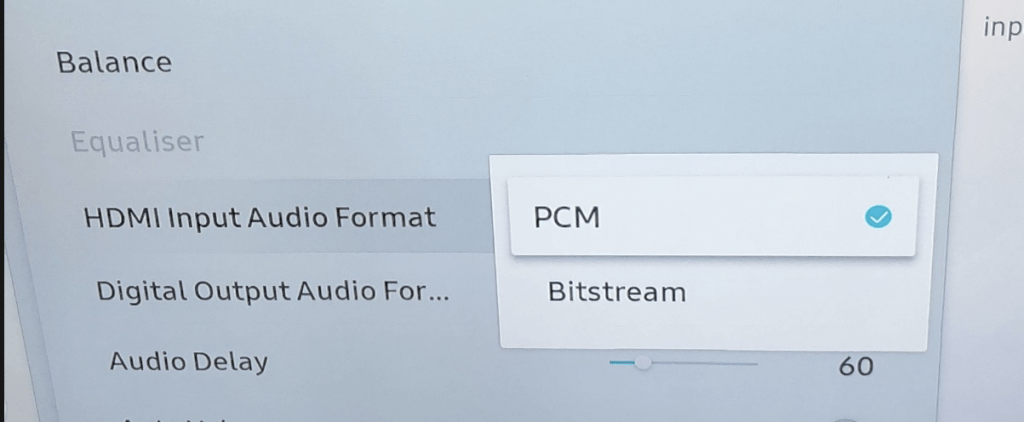In this article, we will explain the different audio options associated with your Samsung TV and give some information on the best way to connect up your speakers or sound bar. PCM stands for Pulse Code Modulation and is a method by which digital sound is encoded in an analog signal. This is done so that the speaker system can provide precise timing of each sound based on its amplitude or loudness. The benefits of using PCM are that it doesn’t use any extra space in terms of bits, meaning it’s easier to store and playback, but it does take up more power (it requires low-frequency amplification).
Check also: How To Split Samsung TV screen with Multi-View
Table of Contents
Difference between PCM and Bitstream on Samsung TVs
- Bitstream audio enables the TV to process the audio before it is sent to your speakers or sound bar, so it requires less processing by the source devices.
- Audio encoded with PCM needs a TV tuner because the TV doesn’t process it before passing it over to your speakers, meaning that more power is used.
- Some sound engineers have reported that Bitstream audio may have a negative impact on some sounds, which means that PCM may be a better option for particular customers.
- You are unable to use different sources on your Samsung TV with Bitstream audio if you have multiple HDMI inputs and an optical output, as you are not able to select which input should be used for decoding.
What is PCM audio on Samsung TV?
PCM audio on Samsung TVs is supplied in two configurations, either in Dolby Digital Plus (DD+), which is an improved version of the Dolby Digital format that enables sound engineers to create a more precise and realistic sound experience to connect with their audience or as Dolby TrueHD which can provide a more enhanced audio experience.
Not all Samsung TVs support both PCM and Bitstream. Some models only offer one of the two options – these are usually the cheaper models without too many frills. More expensive features will be enabled on these models, such as 7.1 channel surround sound, HDMI 2.0 inputs, and picture-in-picture (PIP).
Check also: Charge Samsung Tv Remote
How does it work?
When you have your choice of which audio format to use on your TV, you will usually find that there are two main methods of connecting the speakers or sound bar. Firstly, the optical output is available, which means that a TV tuner is needed in order to take advantage of the audio format. Secondly, HDMI can be used instead. If your TV has an optical output then you can connect a source device that offers Dolby Digital or DTS surround sound to pass through before sending it over to your Samsung TV for decoding.
You will also find that Samsung TVs offer connections for 7.1 channel surround sound, which can be used to decode the audio from a source device. Many newer cars offer DVD players with Dolby Digital or DTS sound and you can also get Dolby Digital or DTS surround sound on many AV receivers and then send it as an optical audio output to your TV for decoding and then connecting to your speakers.
Is PCM better than Bitstream?
The main advantage of using PCM is that it takes up less space on the hard disc because there is no compression taking place (compression means that a high-bitrate bitstream will use more space than a low-bitrate PCM signal). The disadvantage is that it requires a higher level of amplification in order to work as effectively.
Bitstream audio is more efficient in terms of space and it enables the audio to be processed by the TV prior to sending it over to your speakers, meaning less power is used. The disadvantage of this type of audio is that some sound engineers have reported that the processing can skew the balance and can distort the sound, which means that some customers may prefer PCM instead.
Why does Samsung offer Bitstream audio?
The main reason for having Bitstream audio on a Samsung TV is so that you can use a single cable for all connections. However, it means that you aren’t able to select which audio format you would like the TV to decode. The only option is to use Bitstream audio and pass the audio over to your speakers or sound bar.
At Samsung, we believe that different customers have different needs and preferences, as such, we offer a selection of options when it comes to decoding our audio formats. This is why we encourage our customers to use the optical output as well as Bitstream in order for them to be able to have more control over the sound quality and amplification associated with their speakers or sound bar.
What is Bitstream audio on Samsung TV explained?
Sound encoded with Bitstream audio may have a preference over PCM because it has been optimized over time. Samsung has introduced improvements to the format and this means that the audio signal is more precise and can reproduce sounds with higher quality. When you want to connect the speakers or sound bar to your Samsung TV, this will mean that the decoding will take place on a remote control instead of on your TV screen.
Is Dolby Digital Plus (DD+) audio better than Bitstream?
The main advantage of using DD+ on your Samsung TV is that the sound level is lower and therefore it makes the audio more efficient and suitable for movie playback. Since DD+ is a hybrid DTS, most of the DTS-like sounds are preserved in DD+. The advantage of DD+ over Bitstream is that it has a higher CNR rate, meaning that there can be less distortion and better bass reproduction.
Final Verdict
When you use a Samsung TV, you will find that there are a number of audio formats that can be used in order to take advantage of the built-in surround sound. However, the main difference between PCM and Bitstream is the fact that Bitstream is more efficient in terms of space, but may have a negative impact on some sounds.
While PCM takes up more space, it enables you to have better control over your speakers or sound bar because the audio isn’t pre-processed before being sent over to them and requires less power. Some customers may prefer Bitstream because it does have some benefits over PCM and enables Dolby processing without having to spend extra money on a TV tuner or AV receiver.

Virat Raj is a Digital Marketing Practitioner & International Keynote Speaker currently living a digital nomad lifestyle. During his more than 10 years-long expertise in digital marketing, Virat Raj has been a marketing consultant, trainer, speaker, and author of “Learn Everyday yourself: In Pursuit of Learning” which has sold over 10,000 copies, worldwide.

